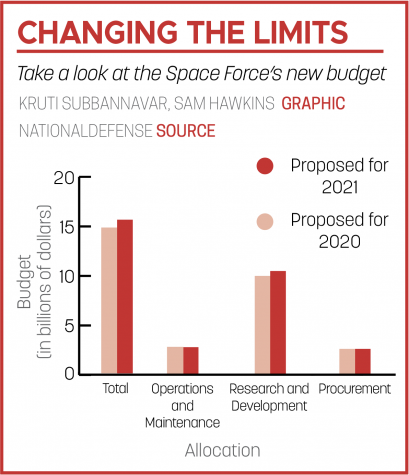When Junior Diego Valencia said he was considering joining the Navy after college, he said one of the most important factors that influenced his decision was his desire to give back to his community.
“Comradeship, travel opportunities (and) the ability to give back to my country, for the most part, is what inspired me the most into looking into joining the armed forces,” he said via email. “The military in general provides lots of wonderful opportunities and experiences.”
When the Space Force was inaugurated as a new branch of the military last December, Valencia said he was intrigued by it.
“I think the Space Force is a cool idea,” he said. “I definitely think having a branch related to space is important especially as technology advances.”
Valencia is not alone. A 2018 poll conducted by The Hill found that 57% of Americans approved of the creation of the Space Force, which, according to U.S. Space Force spokesman Major Nick Mercurio, represents an opportunity for the nation to continue developing its interests in space.
“Today, military space activities do not extend farther than our highest-orbiting satellites,” Mercurio said via email. “However, commercial investments and new technologies have the potential to expand the reach of vital national space interests to cislunar and beyond. It is the responsibility of (the) U.S. Space Force to maintain U.S. advantages in space.”
In late September, the National Aeronautics and Space Administration (NASA) and the Space Force signed a “Memorandum of Understanding,” which served to demonstrate both organizations’ hopes of collaborating in space.
While some people have suggested in the past that the Space Force is replacing many of the functions that NASA has, Mercurio was quick to say this is false,with steps such as signing this memorandum as an example.
“First, it is important to understand NASA and the U.S. Space Force have two distinct mission sets. NASA’s job is science, discovery, exploration. Space Force organizes, trains and equips space forces to protect the freedom of access to, and freedom of operation in space,” he said.
Tejas Kulkarni, an engineer at NASA’s Jet Propulsion Laboratory in California, said he agreed.
“(The goals of NASA and the Space Force) are completely orthogonal to each other in my mind. Our (NASA’s) goals are based on scientific exploration and understanding, and it’s for the benefit of all humankind. We’re trying to learn new things, and that’s what we do,” he said.
One of the projects Kulkarni is currently working on is for the Europa Clipper mission, which hopes to send a spacecraft to Jupiter’s ocean moon Europa and learn more about the possibility of life there.
Although Kulkarni said he doesn’t think the Space Force will have too much interest in gathering data from or playing a role in the Europa Clipper mission, Mercurio did say there is a possibility the circumstances will change.
“We are building the Space Force not for today or tomorrow, but for the next 100 years, so we can see operating in cislunar space, in close coordination with other organizations, a potential for us in the future.”
Senior Luis Withrow, who said he hopes to join the Marine Corps after graduating, said he thinks many of the first thoughts that people have when they think about the purpose of the Space Force may be exaggerated.
“(The Space Force) is a lot like the Air Force. You know, when people say, ‘I’m going to join the Air Force,’ everyone always thinks, ‘Oh, so you’re going to be flying a plane.’ Well, probably not–the only people that get to fly the planes in the Air Force are the pilots, and it’s only a lucky few that get to be that,” he said.
Withrow added that the costs of having the Space Force might distract from the more Earthly focuses of the military.
“Even if this money was only being spent on the military and it wasn’t going to go anywhere else, we have so many programs in the military that deserve more funding,” he said. “We should be picking our battles in a better way. I feel like the only thing that the Space Force benefits for now is the military-industrial complex.”
Kulkarni said, “One thing to note about the Space Force is that there is an international statute that does prevent space from being used in an offensive capacity. So that’s why a lot of the work is cybersecurity and electronic (based), and those things are useful. Those are areas that we do need to pay attention to.”
Mercurio said he agreed that the Space Force’s purpose is focused towards fostering peace.
“Space Force is committed to preserving the safety and accessibility of the space domain so that our nation, and the world, can continue to reap the benefits of space without conflict,” he said. “Space Force looks forward to Space Professionals joining Soldiers, Sailors, Airmen, Marines, (and) Coast Guardsmen in that important role as NASA continues the peaceful human exploration of space.”
Valencia said he hoped more people will join the Space Force and advance its goals.
“The Space Force needs as many people as they can get, and if people are interested in anything related to space they should check it out,” he said.
Regardless of the resulting career track a student chooses, both Mercurio and Kulkarni said there are benefits to choosing something related to national security or aerospace engineering.
“Although people may think that Space Force is only interested in individuals with STEM backgrounds, what the Space Force team really needs are motivated, innovative men and women who can look around corners and anticipate,” Mercurio said, “who think differently and can leverage bold action and cognitive diversity to help tackle the complex problems that will define the future prosperity and security of not only our nation, but of the world.”
“There are a lot of pros and cons to working in any of these fields,” Kulkarni said. “You are working for the benefit of all people and for educational value. What you work on today will be in a textbook tomorrow, and that is the truth. You are working on history, and it is pretty neat to see that happen.”

































![AI in films like "The Brutalist" is convenient, but shouldn’t take priority [opinion]](https://hilite.org/wp-content/uploads/2025/02/catherine-cover-1200x471.jpg)








































![Review: “The Immortal Soul Salvage Yard:” A criminally underrated poetry collection [MUSE]](https://hilite.org/wp-content/uploads/2025/03/71cju6TvqmL._AC_UF10001000_QL80_.jpg)
![Review: "Dog Man" is Unapologetically Chaotic [MUSE]](https://hilite.org/wp-content/uploads/2025/03/dogman-1200x700.jpg)
![Review: "Ne Zha 2": The WeChat family reunion I didn’t know I needed [MUSE]](https://hilite.org/wp-content/uploads/2025/03/unnamed-4.png)
![Review in Print: Maripaz Villar brings a delightfully unique style to the world of WEBTOON [MUSE]](https://hilite.org/wp-content/uploads/2023/12/maripazcover-1200x960.jpg)
![Review: “The Sword of Kaigen” is a masterpiece [MUSE]](https://hilite.org/wp-content/uploads/2023/11/Screenshot-2023-11-26-201051.png)
![Review: Gateron Oil Kings, great linear switches, okay price [MUSE]](https://hilite.org/wp-content/uploads/2023/11/Screenshot-2023-11-26-200553.png)
![Review: “A Haunting in Venice” is a significant improvement from other Agatha Christie adaptations [MUSE]](https://hilite.org/wp-content/uploads/2023/11/e7ee2938a6d422669771bce6d8088521.jpg)
![Review: A Thanksgiving story from elementary school, still just as interesting [MUSE]](https://hilite.org/wp-content/uploads/2023/11/Screenshot-2023-11-26-195514-987x1200.png)
![Review: "When I Fly Towards You", cute, uplifting youth drama [MUSE]](https://hilite.org/wp-content/uploads/2023/09/When-I-Fly-Towards-You-Chinese-drama.png)
![Postcards from Muse: Hawaii Travel Diary [MUSE]](https://hilite.org/wp-content/uploads/2023/09/My-project-1-1200x1200.jpg)
![Review: "Ladybug & Cat Noir: The Movie," departure from original show [MUSE]](https://hilite.org/wp-content/uploads/2023/09/Ladybug__Cat_Noir_-_The_Movie_poster.jpg)
![Review in Print: "Hidden Love" is the cute, uplifting drama everyone needs [MUSE]](https://hilite.org/wp-content/uploads/2023/09/hiddenlovecover-e1693597208225-1030x1200.png)
![Review in Print: "Heartstopper" is the heartwarming queer romance we all need [MUSE]](https://hilite.org/wp-content/uploads/2023/08/museheartstoppercover-1200x654.png)




